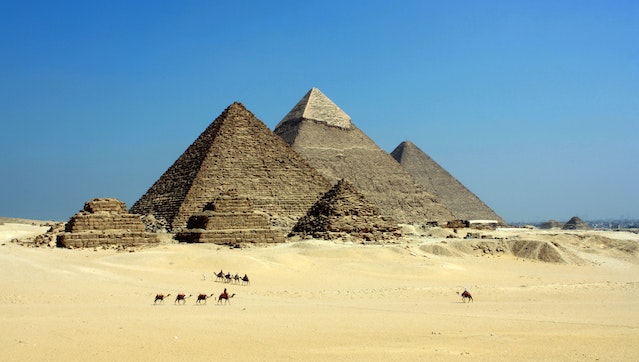
Where is the Land of Punt? It is most likely where Ethiopia, Eritrea, and Somalia are today.
The Land of Punt is an ancient kingdom that existed at the beginning of Ancient Egypt. The pharaohs of Egypt traded with Punt until the the 12th century BC and then trade stopped, for an unknown reason. After that, Punt became a mythical kingdom that Egyptians wrote songs and told stories about. Recently, researchers think they may have found where the Land of Punt was. There is no archaeological evidence for the Land of Punt and nobody knows how big it was or for how long it lasted. There are no buildings, temples, ports, or any other ruins. The only references to Punt are from the Egyptians who travelled there to trade. There were overland routes and it was also possible to get there by boat.
Trade with Punt goes back almost to the beginning of Egyptian civilization. Egypt had been unified by King Menes in 3150 BC and about 600 years later a trade of gold from Punt into Egypt is recorded from the time of Khufu, the pharaoh who commissioned the Great Pyramid of Giza. He was the second pharaoh of the Fourth Dynasty of Egypt and he ruled from 2589 BC to 2566 BC. There is a relief that shows a Puntite with one of Khufu’s sons. The first record of an exhibition to Punt was ordered by Pharaoh Sahure, 25th century BC, and they brought back a cargo of antyue, which is a type of incense.
Trade between Egypt and Punt went on for over a thousand years. They took jewelry, perfumed oils, ornaments, tools, and weapons. They came back with gold, ivory, spices, precious woods, cosmetics, wild animals, animal skins, incense, frankincense, myrrh, and they even brought back live trees. Punt appears to have been a very valuable trading partner with Egypt and there were many expeditions over the years. There was even an Egyptian story written about Punt called the Tale of the Shipwrecked Sailor. However, it appears that trade routes changed sometime around the 20th century BC because of an emerging empire called the Kerma. They were in direct competition with the Egyptians until they were finally defeated in 1500 BC and absorbed into the Kingdom or Egypt. There is a very famous inscription on the wall of a mortuary temple built by Queen Hatshepsut, 1478 to 1458 BC, showing that she sent a large trade mission to Punt. The inscription is very large and is probably showing that Queen Hatshepsut was able to reconnect with Punt after so many years of not trading.
Trade with Punt appears to have stopped in the New Kingdom period of Egypt. The last pharaoh to trade with Punt was Ramesses III, 1186 to 1155 BC. Nobody knows why trade stopped. After trading ceased, Punt became a mythical land to the Egyptians. They called it Ta netjer, meaning “god’s land”.
How could a land that was presumably close to Egypt and presumably important, just vanish? How could it just be forgotten and where was it? There have been many theories as to the location of Punt. People have looked at the items that were traded and guessed at where those things might have come from. The most logical arguments are for a location somewhere on the Horn of Africa, which is made up of the countries of Ethiopia, Eritrea, Somalia, and Dijibouti. Myrrh and frankincense are found there. As are many of the wild animals that were traded with Egypt. Since then, three discoveries have served to increase the likelihood that the Horn of Africa is the best location for Punt.
The first discovery was made by researchers at the University of California. They looked at hair from two mummified baboons that had come from Punt. They used oxygen isotope analysis to compare the hair of those baboons with modern day baboons and they found they were a match for baboons living in Eritrea and Ethiopia. Then some Polish archaeologists discovered a picture of a secretary bird on the temple of Hatshepsut. The secretary bird is native to the Horn of Africa. And, finally, primatologists looked at the mummified baboons again and worked out that they were hamadryas baboons, which are native to the Horn of Africa.
In the Horn of Africa, a civilization called the Gash Group lived from about 3100 BC to approximately 1800 BC. They lived roughly where Ethiopia, Somalia, and Eritrea are today. They have not left much for archaeologists, but there is a lot of pottery. Amongst that pottery is some Egyptian pottery and other artifacts. This shows that the Gash Group had contact with Egypt, and they disappeared at roughly the same time that trade stopped. Were the Gash Group the Land of Punt? Perhaps they were a part of it. Could such an important trading partner with the Kingdom of Egypt really have disappeared without leaving much archaeological evidence? Perhaps we will find out one day. For now, there is only speculation. And this is what I learned today.
Photo by David McEachan: https://www.pexels.com/photo/gray-pyramid-on-dessert-under-blue-sky-71241/
Sources
https://journals.sagepub.com/doi/full/10.1177/0307513320966615
https://www.worldhistory.org/punt/
http://www.thathistorynerd.com/2018/01/punt-mythical-land-of-where.html
https://www.africanhistoryextra.com/p/demystifying-the-ancient-land-of
https://en.wikipedia.org/wiki/Ancient_Egypt
https://www.pbs.org/wgbh/nova/article/egypt-punt/
http://www.touregypt.net/featurestories/punt.htm
